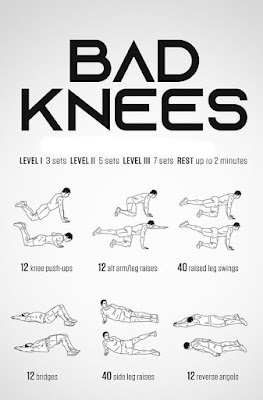how to exercise with bad knees to lose weight
Causes of Bad Knee
There are so many Reasons of Causes of Knee injury,Arthritis and Injury are very common.If you are having a hard time losing weight, try exercising with bad knees. These exercises help your knee and hip muscles work harder and improve the strength of your legs.
Many people who have knee problems can still exercise, but it may be more difficult to do so. If you want to lose weight and tone your muscles, you need to find an exercise program that will give you the results you want. Here are some tips on how to exercise with bad knees:
 |
| Best Exercise With Bad Knees To Lose Weight |
Low-Impact Workouts
Before we dive into the workout modifications, let’s talk low-effect workout. A low-effect exercising is a exercising that places much less strain in your joints.What are a few examples of low-effect exercises? Low-effect aerobic sporting events encompass cycling, walking, or swimming. Low-effect energy exercises encompass the usage of resistance bands and restriction the usage of weights which could damage the joints.
The most important motive of low-effect exercises is to hold the strain off your knees and different joints whilst nevertheless permitting you to workout.
Low-Impact Cardio
One type of low-impact workout is low-impact cardio. Low impact cardio is a form of exercise that increases your heart rate while minimizing the amount of stress or impact you put on your joints.Cardio workouts will cause your heart rate to increase as you work harder and require more oxygen, meaning you’ll need to breathe faster and deeper. Low-impact exercises still allow for the benefits of cardio without placing stress on your joints or spine.
Low-impact cardio doesn’t mean low intensity, though. Low-impact cardio workouts can still allow you to break a sweat and elevate your heart rate, just like traditional high-impact cardio.
Low Impact Strength
Strength training exercises that have minimal impact on the joints are considered low impact exercises. Low-impact strength training is often done with machines because it reduces the risk of injury and takes some stress off the joints. .Another way to achieve low-impact strength training is to incorporate exercise bands into your workout routine to experience a full-body strength workout that doesn't stress any specific joint. The exercise bands allow you to perform movements like push-ups or squats without putting stress on your spine, knees and other important joints.Research shows that resistance band and tube training programs produce results that are equivalent to free weight training.
Weight Loss With Low-Impact Workouts
Can you lose weight with a low-impact exercise? Low-impact exercises can be modified to make them more intense by involving your entire body. Some tips for making low-impact workouts more intense are:
Incorporate upper body
Exercising with bad knees can be challenging, but there are steps that you can take to have a good workout. Upper body moves like swinging your arms when walking and raising the arms overhead during step or aerobics can help increase the intensity of your workout without causing too much discomfort for your knees. Machines at the gym that offer exercises for upper body muscles like an elliptical trainer or cross-country ski machine, may also serve as a helpful workout option if you’re suffering from painful knees.
Exaggerate your movements
Add intensity to your exercises by using big, exaggerated movements. For example, if you were marching in place, making the movement harder by bringing the knees up high and circling the arms overhead. Sure, you might look a little silly, but it’s worth it!
Increase speed
When it comes to your low-intensity workout routine, adding speed is one way to increase the intensity and get your heart rate up. Always be careful when increasing your speed. Pay attention to how your knees, hips, and joints feel.
Exercise Modifications For Bad Knees:
Most leg joint pain actually stems from a lack of strength in your legs. How’s that for ironic? Yes, strengthening the muscles around your knee joint is one of the best ways to protect you from knee pain. There are all kinds of ways you can work your legs by either modifying traditional leg moves and choosing moves that are effective but more gentle on your knees.Follow along with this video as we show you the five great exercise modifications for bad knees, including glute bridges, squat alternatives for bad knees, and more.
Knee pain happens for a variety of reasons. Regardless of the reason, there tend to be some muscles that get tight and some muscles that are weak
Squat Alternatives for Bad Knees
Don’t worry, there are numerous squat options for terrible knees. First up, we like those balance ball wall squats.
Try: Stability Ball Wall Squats
Instead of a conventional squat, snatch a balance ball, location it among your mid-returned and the wall. These squats for terrible knees will nonetheless assist you figure your decrease frame with out setting strain to your joints.Lean barely returned towards the ball together along with your toes shoulder-width aside in the front of you and start your squat.Not best will this take a few strain off your knees, however you’ll additionally be capable of modify the circulate at the fly to fit your very own strengths and weaknesses.Get a experience for this after which upload a few dumbbells to your hand to make it harder.



